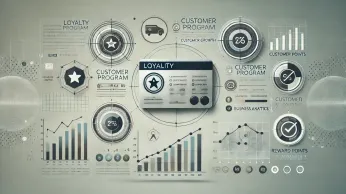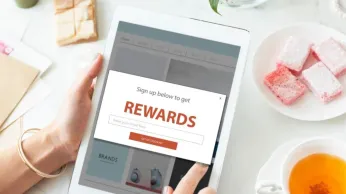On this page
Customer loyalty can be the difference between a thriving business and one that struggles to keep customers coming back. With so many choices out there, it’s crucial to give your customers a reason to stick with you. A loyalty points program can be that reason, turning one-time shoppers into repeat buyers who feel valued and appreciated.
A well-thought-out loyalty points program isn’t just about giving away rewards; it’s about building a lasting connection with your customers.
When customers see that their loyalty is recognized and rewarded, they’re more likely to keep choosing your brand. And as they do, your business benefits from increased sales, repeat purchases, and a stronger customer relationship.
A study by McKinsey, for example, found that customers who are members of a loyalty program are 59% more likely to choose a brand over a competitor and 43% more likely to buy weekly. In fact, the study found that customers who are members of a loyalty program are 62% more likely to spend more on the brand.
In this blog, we’ll explore how to create a loyalty points program that truly works. From understanding the basics to learning from companies that have done it right, you’ll get the insights you need to start building a program that keeps your customers coming back for more.
What is a loyalty points program?
Loyalty points programs are a powerful tool for businesses looking to build long-term relationships with their customers. At their core, these programs reward customers for their repeat business, encouraging them to choose your brand over others.
However, not all loyalty programs are the same, and understanding the different types can help you design one that fits your business and appeals to your customers.
A loyalty points program is a system where customers earn points for specific actions, like making purchases, referring friends, or engaging with your brand online. These points can then be redeemed for rewards, such as discounts, free products, or exclusive offers. The goal is to create an incentive for customers to continue doing business with you.
The loyalty points system is more than just a way to say "thank you" to your customers. They are a strategic approach to boosting customer retention and increasing the lifetime value of each customer. When customers feel that their loyalty is rewarded, they’re more likely to return, spend more, and even spread the word to others.
What are the types of loyalty programs?
Here are the types of loyalty programs:
1. Points-based programs
Points-based program are the most common type of loyalty program, where customers earn points for each purchase they make. The points can be redeemed for rewards, encouraging repeat purchases.
A well-known bank wanted to improve customer engagement for a point-based rewards program. Loyalife provided a digital rewards platform for this purpose. The platform allowed the bank to offer personalized rewards to its customers.
Loyalife created a modern, mobile-friendly redemption portal. This portal made it easy for customers to log in, browse, and redeem points using Single Sign-On (SSO), enhancing both security and convenience. This initiative led to improved customer satisfaction and higher retention rates.
Data showed increased participation in the rewards program, resulting in higher transaction volumes and greater profitability for the bank.
2. Tiered programs
Tiered programs offer different levels of rewards based on the customer’s engagement with the brand. The more a customer spends, the higher their tier, and the better the rewards they receive.
3. Pay-per-purchase programs
In these programs, customers pay a small fee to join the loyalty program, which then allows them to earn points or receive discounts on every purchase.
Understanding these different types of loyalty programs helps you tailor a system that aligns with your business goals and customer expectations. The key is to choose a structure that motivates your customers while being easy to manage and sustain.
Suggested Read: Enterprise Loyalty Program: Best Practices to Learn from Fortune 500 Enterprises (2025)
Examples of companies with successful loyalty points programs
Following are loyalty points examples of companies:
1. Starbucks rewards
Source: Starbucks
Starbucks Rewards is one of the most recognized and successful loyalty programs in the retail industry. Launched in 2009, it has become a cornerstone of Starbucks' customer engagement strategy, driving repeat business and deepening customer loyalty. The program’s appeal lies in its simplicity, accessibility, and the tangible rewards it offers.
How it works: Customers earn “Stars” for every dollar spent at Starbucks, whether they’re purchasing in-store, through the app, or online. The points can be accumulated and redeemed for free drinks, food items, and merchandise. Additionally, Starbucks offers bonus Stars for specific purchases, promotional periods, or during customer birthdays, which encourages customers to spend more frequently.
Key features:
- Tiered rewards system: Starbucks Rewards has a two-tier structure—Green and Gold levels. Customers start at the Green level, where they can earn free in-store refills, and after earning 300 Stars within a year, they achieve Gold status. Gold members receive additional perks, including monthly Double-Star Days and personalized offers.
- Mobile integration: The Starbucks mobile app is a critical component of the loyalty program. It allows customers to track their Stars, order ahead, pay in-store, and even send gift cards to friends. The app's ease of use and integration with the loyalty program have significantly increased customer engagement.
- Personalization: Starbucks uses data from the program to offer personalized deals and recommendations, making customers feel valued and understood. This personalization extends to the way rewards are delivered, ensuring that the offers are relevant to each customer’s preferences and purchase history.
Impact
Starbucks Rewards has over 26 million active members in the U.S. alone, accounting for nearly half of the company’s sales. The program has been instrumental in increasing customer frequency, as members visit more often and spend more per visit compared to non-members. The loyalty program also plays a crucial role in gathering customer data, which Starbucks uses to refine its marketing strategies and enhance customer experiences.
2. Sephora’s Beauty Insider
Source: Sephora
Sephora’s Beauty Insider program is a premier example of how a loyalty program can elevate customer engagement in the beauty industry. Launched in 2007, the program has evolved over the years to become a sophisticated, multi-tiered system that rewards customers not just for purchases but for their overall relationship with the brand.
How it works: Customers earn points for every dollar spent at Sephora, either in-store or online. These points can be redeemed for a variety of rewards, including exclusive products, limited-edition items, and beauty experiences. The program is structured into three tiers: Insider, VIB (Very Important Beauty Insider), and Rouge, each offering progressively more luxurious benefits.
Key features:
- Tiered benefits: The Beauty Insider program is designed to incentivize increased spending. As customers move up through the tiers—from Insider (free to join) to VIB (after spending $350 in a year) and Rouge (after spending $1,000 in a year)—they unlock exclusive perks such as early access to sales, free beauty classes, and complimentary makeovers.
- Experiential rewards: Beyond products, Sephora offers unique experiences as part of its rewards, including invitations to private events, one-on-one beauty consultations, and opportunities to redeem points for special events, like meet-and-greets with top beauty influencers or brand founders.
- Personalization: Sephora tailors its offerings to individual customers based on their purchase history, preferences, and past interactions. This personalized approach ensures that the rewards are relevant and desirable, increasing the likelihood that customers will engage with the program.
Impact
The Beauty Insider program has been incredibly successful in driving customer loyalty and increasing spend. Members are reported to spend twice as much as non-members, and the program has played a significant role in Sephora's ability to retain customers in a competitive market. The tiered system encourages ongoing engagement, with many customers striving to reach the higher tiers for more exclusive benefits.
3. Amazon Prime
Amazon Prime is more than just a loyalty program; it’s a comprehensive membership service that offers a wide array of benefits designed to enhance the customer experience. Launched in 2005, Amazon Prime has grown into a powerhouse, attracting millions of subscribers worldwide who are fiercely loyal to the brand.
How it works
For an annual or monthly fee, Amazon Prime members gain access to a host of benefits, including free two-day shipping, same-day delivery in certain areas, streaming services (Prime Video and Prime Music), and exclusive access to deals and discounts. Additionally, Amazon offers a points-based rewards system through the Prime Rewards Visa Signature Card, where members earn points on every purchase that can be redeemed for cash back or Amazon purchases.
Key features:
- Comprehensive benefits: Prime offers a broad range of benefits that appeal to different aspects of a customer’s life, from shopping to entertainment. This multifaceted approach ensures that members feel they are getting value from the membership in multiple ways, which enhances their overall satisfaction and loyalty.
- Subscription model: Unlike typical loyalty programs, Amazon Prime operates on a subscription basis, which means customers are more invested in getting the most out of their membership. The recurring nature of the fee encourages ongoing engagement with Amazon services.
- Seamless integration: Amazon has integrated the Prime membership across its entire ecosystem, from retail to entertainment. This integration means that Prime members are constantly reminded of their benefits, whether they’re shopping on Amazon, watching Prime Video, or using other Amazon services.
Impact
Amazon Prime has over 200 million members globally, and these members spend significantly more on Amazon than non-members. The program has been a critical driver of Amazon’s revenue growth, with Prime members shopping more frequently and across more categories. The comprehensive nature of the benefits and the seamless integration across Amazon’s services have made Prime one of the most successful and influential loyalty programs in the world.
4. Nordstrom’s The Nordy Club
Source: Nordstrom
Nordstrom, a leading fashion retailer, has built a strong customer base with its loyalty program, The Nordy Club. This program is designed to reward customers not only for their purchases but also for their engagement with the brand, such as writing reviews or attending store events. Launched as an evolution of their original program, The Nordy Club combines traditional point-based rewards with experiential benefits, making it a comprehensive loyalty initiative.
How it works: The Nordy Club members earn points for every dollar spent at Nordstrom, Nordstrom Rack, and Hautelook, both in-store and online. These points can be redeemed for Nordstrom Notes, which are essentially store credits that can be used for future purchases. The program is tiered, with different levels based on annual spending, offering increasing benefits as customers spend more.
Key features:
- Tiered membership: The Nordy Club is divided into four tiers: Member, Influencer, Ambassador, and Icon. Each tier offers progressively more benefits, such as access to exclusive sales, personalized styling services, and free alterations. The Icon tier, for instance, offers top-tier members VIP experiences, including early access to anniversary sales and invitations to exclusive events.
- Experiential rewards: Beyond the points system, The Nordy Club offers members experiences that enhance their relationship with the brand. These include invitations to in-store events, priority access to new arrivals, and personal shopping experiences. Nordstrom also rewards customers for engaging with the brand through activities like writing product reviews, which adds a layer of engagement beyond just shopping.
- Integration with Nordstrom card: Customers who hold a Nordstrom credit card earn points faster and receive additional perks, such as early access to sales and special financing options. This integration encourages customers to not only join the loyalty program but also to use the Nordstrom card for their purchases.
Impact
The Nordy Club has been successful in driving customer loyalty, with members spending significantly more than non-members. The combination of points, personalized experiences, and exclusive access has helped Nordstrom maintain strong relationships with its customers. The program’s emphasis on both rewards and experiences has made it a model for how to blend traditional loyalty elements with modern, engagement-focused strategies.
Key components of an effective loyalty points program
Designing a successful loyalty points program requires more than just offering rewards. To truly engage your customers and encourage repeat business, it’s important to build a program that’s well-structured, easy to use, and aligned with what your customers value. Here are the key components to consider:
- Setting clear objectives: Before you start, it’s essential to define what you want to achieve with your loyalty program. Are you aiming to increase customer retention, boost sales, or enhance customer engagement? Clear objectives will guide every decision you make, from the types of rewards you offer to how you promote the program.
- Determining point structure: The point structure is the backbone of your loyalty program. It determines how customers earn points and what those points are worth. For example, you might offer one point for every dollar spent, or you could reward customers for specific actions like referring a friend or writing a review. The key is to make the point system simple and transparent so customers know exactly how to earn and redeem their points.
- Choosing rewards: The rewards you offer should be appealing enough to motivate customers to participate. Common rewards include discounts, free products, or exclusive access to new products or services. However, the best rewards are those that resonate with your customers. Consider offering a mix of rewards that cater to different preferences, ensuring there’s something for everyone.
- Personalization and customization: Not all customers are the same, and your loyalty program shouldn’t be one-size-fits-all. Personalization can make your program more effective by tailoring rewards and offers to individual customer preferences and behaviors. For example, you might offer different rewards based on a customer’s shopping habits or past interactions with your brand.
- Ensuring accessibility: A successful loyalty points program is easy for customers to join, use, and understand. Make sure your program is accessible both online and in-store and that customers can easily track their points and redeem rewards. The more seamless the experience, the more likely customers are to stay engaged.
These components are crucial in creating a loyalty points program that not only attracts customers but also keeps them engaged over the long term. By focusing on what your customers value and ensuring the program is easy to use, you can build a loyalty strategy that truly benefits both your business and your customers.
How to run a loyalty points programs
Here are steps on how to run a loyalty points program:
1. Planning your loyalty points program
- Set clear goals
Establish clear goals for your loyalty program, such as promoting customer referrals or improving customer retention. Well-defined objectives give direction and help in gauging the program's effectiveness.
- Identifying the target audience and segmenting customers
Recognize your clientele and divide them into groups according to their preferences, buying patterns, and demographics. Customizing your loyalty program that appeals to distinct client segments enables more focused rewards and personal interactions.
- Choosing the right type of loyalty program
Select a loyalty points program structure that aligns with your business model and customer preferences. Whether it's points-based, tiered, cashback, or subscription-based, choose the format that best resonates with your audience and supports your goals.
- Determining reward structure and incentives
Create an intriguing incentive system that encourages desired behaviors and boosts client interaction. To accommodate a range of consumer preferences, think about providing a combination of intangible and tangible benefits, such as VIP access and customized services, as well as freebies, exclusive perks, or discounts.
2. Implementing your loyalty points program
- Selecting the right loyalty management system
Select a loyalty management system that is appropriate for your company's demands and size. To improve program operations and customer experience, look for features like reward management, customer analytics, point tracking, and integration possibilities.
Loyalife is one such comprehensive tool that has a solution for all your needs. Check it out!
- Integrating loyalty programs across channels
Make sure that your loyalty program is seamlessly integrated with all different customer touchpoints, such as social media, mobile apps, physical stores, and internet platforms. Customers can more easily find and interact with programs when branding and messaging are consistent across all platforms.
- Communicating program details to customer
Make sure that your consumers understand the advantages, guidelines, and workings of your loyalty points program. You can do this by sending them emails, posting on social media, placing banner ads on your website, and displaying signs in-store. Open communication fosters participation from clients and increases trust.
- Training staff for program execution
Give frontline employees training so they can run and market the loyalty points program successfully. Give them the tools needed to provide an ideal client experience and teach them about program features, enrollment procedures, reward redemption methods, and ways to resolve issues.
3. Managing and monitoring your loyalty program
- Tracking and analyzing customer data
To monitor and evaluate consumer behavior, preferences, and loyalty points program engagement, use data analytics technologies. You may better serve your client's demands and increase engagement by customizing rewards and incentives based on their interactions with the program.
- Measuring program effectiveness and ROI
To evaluate the success of your loyalty program, set up key performance indicators (KPIs) such as frequency of purchases, average order value, and customer retention rates. Examine these indicators regularly to determine the ROI of the program and pinpoint areas that need work.
- Gathering feedback and making improvements
Ask program participants for their opinions via questionnaires, reviews, or direct correspondence. Utilize this input to identify problem areas, respond to client inquiries, and enhance the program experience over time.
- Preventing fraud and ensuring program security
To protect your loyalty program from fraud, unauthorized access, or exploitation, put strong security measures in place. To safeguard client accounts and stop fraudulent activity, make use of fraud detection algorithms, multi-factor authentication, and encryption technology.
4. Promoting and evolving your loyalty program
- Offering special promotions and exclusive offers
Regularly remind members about your loyalty points program with exclusive deals. These could be exclusive access to new goods or services, time-limited discounts, or bonus point events. You may encourage program participants to continue participating and making purchases by offering them additional value.
- Adapting to changing customer needs and preferences
By gathering input from program participants and keeping an eye on market dynamics, you can stay aware of evolving consumer preferences and trends. Sustainability requires flexibility, so be ready to modify your loyalty point program's incentives, offers, and communication tactics to better suit your clients' changing demands.
- Innovating and expanding the program benefits
Make sure your loyalty points program is always creative and interesting by adding new features and benefits. To maintain member participation and interest, introduce benefits and redemption alternatives. To improve the entire program experience and give your clients more value, think about forming alliances with other companies to build better loyalty programs.
Indonesian hotel chain achieves 23% loyalty membership growth with Loyalife
An Indonesian hotel chain leveraged Loyalife to elevate its loyalty program, achieving remarkable results in just six months. Renowned for its exceptional hospitality and cultural authenticity, the hotel aimed to deepen connections with guests and drive repeat bookings through a personalized and seamless loyalty experience.
The challenge
To enhance customer retention and revenue, the hotel chain sought to:
- Encourage frequent visits and longer stays through a tiered rewards system.
- Deliver personalized experiences aligned with diverse guest preferences.
- Integrate the loyalty program seamlessly with existing booking systems for a unified experience.
The solution
Loyalife empowered the hotel to design and execute targeted retention campaigns tailored to loyalty program members. Key features included:
- Personalized loyalty experience: Rewards and communications customized to individual guest behaviors and preferences.
- Omnichannel communication: Timely updates via email, SMS, and in-app notifications to enhance engagement.
- Diverse reward options: Choices ranging from room upgrades to dining experiences catering to varied guest interests.
- Points multiplier: Promotional periods offering bonus points to incentivize bookings.
- Campaign management Tools: Streamlined design and monitoring of targeted campaigns, increasing efficiency and effectiveness.
The results
The partnership with Loyalife delivered outstanding outcomes:
- 23% growth in new loyalty program memberships within six months.
- Over 38,000 annual long-stay bookings, driven by tailored rewards and promotions.
- Immediate uplift in booking rates post-campaign launch, showcasing the program's success.
By adopting Loyalife, the Indonesian hotel chain transformed its loyalty program, creating meaningful guest experiences and achieving significant growth in customer engagement and retention.
Using Loyalife for running loyalty points programs
Loyalife is an all-in-one platform that empowers businesses to create, manage, and optimize their loyalty points programs seamlessly. With Loyalife, you can launch a fully customizable and scalable loyalty program that caters to your unique business needs and customer preferences. The platform is designed to simplify every aspect of running a loyalty program, from onboarding customers to driving engagement through personalized campaigns.
Key features of Loyalife:
- Customizable loyalty engine 🛠️: Loyalife's loyalty engine allows you to create engaging loyalty programs tailored to your brand and customer base. Whether you want to offer points for purchases, referrals, or other customer actions, the platform gives you the flexibility to design a program that resonates with your audience.
- Omnichannel interface 🌐: Loyalife provides an omnichannel interface, enabling you to engage with your customers across multiple touchpoints—online, in-store, via mobile apps, and more. This ensures a consistent and seamless experience for your customers, no matter where they interact with your brand.
- Conversational AI interface 🤖: Managing a loyalty program can be complex, but Loyalife simplifies administrative tasks with a conversational AI interface. This feature automates routine tasks, making it easier for your team to focus on strategy and customer engagement rather than day-to-day operations.
- Personalized customer engagement 💬: Loyalife helps you leverage member segments to run personalized multichannel marketing campaigns. You can customize templates to match your specific needs, ensuring that your messaging is relevant and impactful for each customer segment.
- Analytics & insights 📊: Data-driven decisions are at the core of successful loyalty programs. Loyalife's advanced AI-enabled analytics provide deep insights across every touchpoint of your program. This allows you to monitor performance, identify trends, and optimize your engagement strategies in real time.
- Extensive redemption options 🎁: Loyalife offers your customers a world of redemption possibilities, with over 10 million options, including travel bookings, gift cards, merchandise, experiences, and even charity donations. This variety ensures that your loyalty program can cater to the diverse preferences of your customer base.
💡Loyalife simplifies the complexity of running a loyalty points program, allowing you to focus on what truly matters—building lasting relationships with your customers and driving business growth. Whether you're launching a new program or scaling an existing one, Loyalife provides the tools and support you need to succeed. Connect with our team now.
Conclusion
A well-crafted loyalty points program can be a game-changer for building lasting customer relationships. As seen in examples from Starbucks, Sephora, Amazon, Nordstrom, and Hilton, these programs do more than just offer rewards—they create strong connections between brands and their customers. By focusing on what your customers truly value, you can design a program that motivates repeat business and enhances loyalty.
Start with clear objectives, a straightforward points system, and rewards that resonate with your audience. Personalization and simplicity are key to keeping customers engaged. As you roll out your program, pay attention to feedback and make adjustments as needed to keep it effective.
With the right approach, your loyalty points program can become a vital part of your strategy.
FAQs
1. Why should my business have a loyalty points program?
A loyalty points program encourages repeat business, increases customer retention, and strengthens customer relationships by rewarding customers for their continued support.
2. How do I determine the point structure for my loyalty program?
The point structure should be simple and transparent, typically awarding points based on the amount spent or specific actions taken. Consider what will motivate your customers while balancing the cost to your business.
3. What types of rewards should I offer in a loyalty points program?
Rewards can include discounts, free products, exclusive access to sales or events, and personalized offers. The key is to offer rewards that are meaningful and desirable to your customers.
4. How can I personalize my loyalty points program?
Personalization can be achieved by tailoring rewards and offers based on individual customer preferences, shopping habits, and past interactions with your brand.
5. What are the benefits of a tiered loyalty points program?
A tiered program rewards customers with progressively better benefits as they spend more, encouraging higher spending and greater engagement. It also provides a sense of achievement and exclusivity for top-tier members.
6. How can I ensure my loyalty program is easy to use?
Ensure that your program is accessible both online and in-store, with a straightforward process for earning and redeeming points. Providing a user-friendly platform where customers can track their points and rewards is essential.
7. How do I measure the success of my loyalty points program?
Track key metrics such as customer retention rates, repeat purchase frequency, and program participation. Regularly gather customer feedback to assess satisfaction and identify areas for improvement.
8. What are some common challenges with loyalty points programs, and how can they be overcome?
Challenges include low participation, reward fatigue, and managing costs. These can be overcome by offering attractive rewards, regularly updating the program, and keeping it simple and engaging for customers.
9. How do I promote my loyalty points program to customers?
Promote your program through various channels such as email marketing, social media, in-store signage, and your website. Highlight the benefits and ease of joining to encourage participation.








